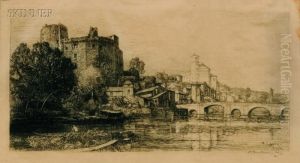Alfred Edouard A. Lepere Paintings
Alfred Edouard A. Lepere, born in Paris, France, on May 30, 1849, was a prominent figure in the realm of printmaking and engraving in the late 19th and early 20th centuries. His work is often associated with the etching revival that swept through Europe and the United States during his lifetime, marking a period of renewed interest in the traditional techniques of etching and wood engraving. Lepere was among the artists who pioneered the integration of Japanese woodblock influences into Western art, a movement that was part of the larger Japonism trend prevalent among European artists during the late 19th century.
Lepere's career began in the architectural field, but he quickly shifted his focus to graphic arts, where he found his true calling. He was particularly skilled in wood engraving and etching, disciplines through which he achieved a high level of detail and texture, making his work highly sought after by collectors and publications alike. His subjects often included cityscapes and landscapes, capturing the essence of French urban and rural life with a keen eye for detail and an evident appreciation for the environment.
Throughout his career, Lepere was involved in various artistic circles and collaborated with many publications, contributing illustrations and prints that were celebrated for their technical skill and artistic beauty. He was also a mentor to younger artists, passing on his skills and knowledge of wood engraving and etching. His impact on the graphic arts was significant, helping to elevate printmaking to a fine art form during a period when it was often considered merely a craft.
Alfred Lepere's contributions to the art world were recognized through numerous awards and honors during his lifetime, and his works continue to be admired for their technical excellence and artistic expression. He died on November 20, 1918, leaving behind a legacy that continues to influence the world of printmaking and engraving. His dedication to his craft and his innovative approaches to traditional techniques have cemented his status as one of the leading figures in the history of French printmaking.
